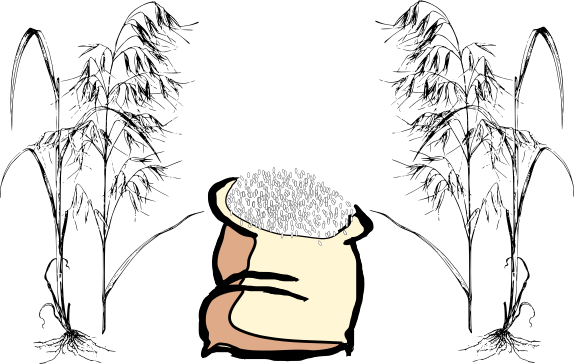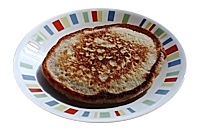The Amish Home-made Pancakes recipe may be the best-tasting Amish pancake recipe available.
Yet, I tend to try and improve perfection.
The Amish Home-made Pancakes recipe contains sugar, which I needed to get rid of. I'm on a low-carb diet and the processed sugar was creating havoc.
And good-bye to the salt. I tend toward high blood pressure, which salt can aggravate.
White flour is also much higher in carbs than warranted for the nutrition it (does not) provide. It had to go. The only grain left in the recipe, then, was the whole wheat flour and the oatmeal.
I thought to myself, "Why not replace all the grain with whole-grain oat flour?!"

Whole-grain oats has much to recommend it:
- It is high in fiber.
- It is high in antioxidants (compared to wheat flour).
- None of its carbs are from processed sugars.
- It is low-glycemic (compared to wheat flour).
- It is gluten-free.
All that in a pancake would be a really-good-for-you plate of yummy.
So I set out to update the Amish Home-made Pancakes recipe, omitting the sugar and salt, and with all grains swapped out for whole-grain oat flour.
(Oat flour can be made at home with oatmeal and a blender.)
Because we have pancakes only on Sunday mornings, it took over a month of testing to perfect the recipe.
A tentative ingredient list was written out. The recipe and cooking instructions would come after a bit of trial and error.
First off, the leavening needed a bit of adjustment. The rise seemed late.
I tried replacing the cream of tarter with baking soda. That didn't work well. The rise happened before the batter hit the skillet.
I ended up adjusting proportions to a good balance of baking powder and cream of tartar.
Early on, I found out oat flour thickens slower than wheat flour. I needed to let the milk and dry mixture set for at least 5 minutes, preferably 10 minutes, before starting the cooking. That also let the leavening work better.
Oat-flour Pancakes
Here is the recipe for the oat-flour pancakes evolved from the Amish Home-made Pancakes recipe.
Oat-flour Pancakes
(Evolved in the author's kitchen.)
1 cup whole-grain oat flour (can be made with oatmeal and a blender)
2 teaspoons baking powder
1/2 teaspoon cream of tartar
1 egg white
2 tablespoons vegetable oil (optional)
3/4 - 1 cup milk

In a mixing bowl, mix the dry ingredients.
Add the egg white to the dry ingredients. Also the vegetable oil (optional, but pancake may break apart easier) and about half the milk. Stir until much of the dry ingredients are moistened and the egg has been well distributed.
Add the the rest of the milk. (Start with 3/4 cup altogether and add more if needed.) Stir until all is wet and consistent. The thinner the dough, the thinner the pancake — and vice versa.
Let the batter stand 5 to 10 minutes to give it a chance to get a little thicker. The oat flour absorbs moisture slower than may be expected. (The batter slowly keeps getting thicker. If you take a long time making pancakes, more milk may be added to thin the batter.)
When ready, grease a pre-heated frying pan or griddle. Use medium to medium-high heat.
Spoon or pour pancake dough onto the hot surface until it looks like the resulting pancake will be about the right size. If uncertain, start with a third cup of pancake dough for one pancake.
Let cook 5-7 minutes or until bubbles on top of the pancake pop and don't close. (Timing depends on how hot the skillet is, how thick the batter is, and how much batter is in the skillet.)
Cook the second side until browned. This should take a bit less time than the first side, maybe 4-5 minutes.
Put the pancake on a plate. Add toppings as you prefer.
Yields approximately 6 pancakes at 1/2 cup of batter for each — about 10 carbs per pancake. (Using almond milk instead of dairy milk brings it down to about 9 carbs each.)
Note: The pancake batter gets thicker as it sits. Stir in more milk if it gets too thick. More milk, of course, will raise the yield.
Enjoy the taste. It's different than wheat-flour pancakes. To me, it tastes more wholesome.
The pancake will look a bit different than wheat-flour pancakes. Oat flour cooks different. It may be darker than expected coming out of the skillet, or have dark spots or streaks. (Dark spots or streaks are likely to be bits of oat flour getting very hot against the bottom of the pan.)
Topping can be butter, peanut butter, syrup with or without peanut butter, or topping suggestions from this pancake page.





